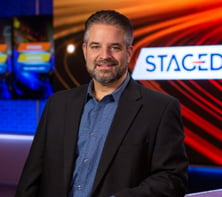A Q&A With Art Director Jason Courtemanche
 When you think about an event brand, you might imagine a logo printed on a swag bag. But event branding involves so much more. What went into the creation of that logo? And how did the overall event brand support and improve the attendee journey?
When you think about an event brand, you might imagine a logo printed on a swag bag. But event branding involves so much more. What went into the creation of that logo? And how did the overall event brand support and improve the attendee journey?
We sat down with Stagedge Art Director Jason Courtemanche, who’s been working in the events industry for almost 30 years, to learn what it takes to develop a complete event brand—including a key test of any logo’s success.
Q: Let’s start with the basics. What is an event brand, and why do your clients need one?
JC: An event brand is separate from the company’s corporate brand—although we always adhere to any corporate brand guidelines. Like any good brand, an event brand should help attendees understand what they will get from an event before they even set foot in the venue.
Any time you see inconsistency—like different versions of the brand online versus in-person—it leads to uncertainty and discomfort for audience members. They might even think they’re in the wrong place.
Q: How does Stagedge approach creative and design?
JC: We always start with the experience side of things: What’s unique about what audiences will see here? What’s the takeaway we want them to have? Then the creative team—myself and a team of art directors—takes that and makes it into a series of visuals. We create a logo, a theme, and a “hero image”—the attention-grabbing image that's used as the backdrop for a logo or website—that can be used throughout the attendee journey. Our job is to create a brand that can scale across multiple mediums and applications.
"Stagedge takes an "experience-first" approach to design. The creative team looks at what the audiences will see and experience and then creates a brand that reinforces and enhances the audience's journey."
It’s crucial for any event—especially a large one—to have a creative team. Many different folks end up touching the brand. The creative team might develop it, but the video services team gives it movement, vendors are using it to develop ancillary experiences, and the company’s internal team is using it to create breakout content. The creative team ensures that it all stays unified, providing a check to make sure that on event day, every aspect of the event feels cohesive.
Q: Tell us more about developing an event brand that scales. That’s tricky!
JC: Yeah, the most important thing to look at is the logo mark. Can it be printed in one color? If it can’t be printed in one color, your logo is unsuccessful. The logo has to be just as clear and meaningful printed in one color on your event swag as on a two-story tall, full-color LED screen.
Event brands must be scalable across many different mediums and applications. The event brand is visible in every aspect of any event, from badges, registration, swag, and wayfinding to staging, scenic, content, and any ancillary activities.
On top of being easily legible across mediums, the event visuals need to be unique. If you go to an event and the hero image is a stock photo you feel like you’ve seen before, it feels less special, and you lose the “wow” factor that’s a foundational part of a successful event experience.

Q: What are some of the coolest ways you’ve seen event brands used?
JC: I love to see anything interactive—where attendees get to contribute in some way to event visuals. As an example, if we’re using a tree or something organic as the hero image, we might have a commitment wall where attendees can add their goals for the year or even their signature. The visual becomes this growing, changing product that everyone can contribute to and be proud of.
Q: What’s something you wish your clients knew about event branding?
JC: When you make the rules, you can break the rules!
In all seriousness, when our team is empowered to spearhead creative and design across the event, that allows us to be even more innovative. We don’t have to be as concerned about “the rules” because consistency is built into our team. We can stretch the bounds of the brand so that the result is cohesive but interesting and nuanced.
Also, we are here to help you! Please do not spend hours struggling to create a PowerPoint on your own. We can discuss what you need to get across, how you want to get it across and help you build a presentation. I think we all forget sometimes you’re creating a presentation, not just a PowerPoint.

Q: We’ve talked a lot about consistency and cohesion. That’s because an event brand appears on nearly everything! To close us off, can we remind readers where they’ll see branding?
JC: First and foremost: badges. Everyone has to wear one! The badge is probably the most visible thing in the whole conference, and yet sometimes folks think of them as an afterthought. Creating a functional badge takes some thought. How big is the name? Can you see it from 20 feet away?
An event brand ladders up to a corporate brand but has a more specific objective. It communicates what audiences can expect from the event before they set foot in the venue.
Then think about registration: whether virtual, physical, or both, it’s one of the first impressions people get of your event experience. Does it feel seamless and easy? And it’s the same with the event app—another highly visible aspect of an event.
Then there are all the typical things we build for any event, like wayfinding, scenic, staging, and breakouts. We must think about the live-streaming experience nowadays too. If there’s a space—virtual or in-person—and people are using it, it needs to be branded. Are you having a gala at night? How will the décor reflect the event brand? Do you have a speaker at lunch? Don’t forget that the lectern needs to be branded.
Q: Readers should think about branding being everywhere.
JC: That’s right. We never know where our logos are going to go next. That’s what makes our job challenging—and fun.
When it comes to running a top-notch event, it takes a village—and the behind-the-scenes roles are often the most important. To learn about another key figure at Stagedge, read our related Q&A with Director of Sales Operations Richard Ferrara.
Stagedge: Creating Immersive Experiences for 50 years is proud to be one of Boston's premier full-service event production companies, dedicated to conceiving, creating, and executing immersive brand experiences through live, virtual & hybrid events, domestically and worldwide.
